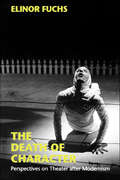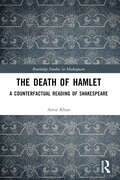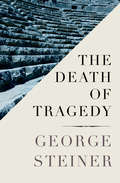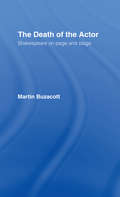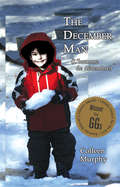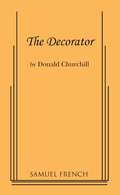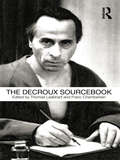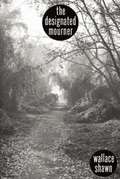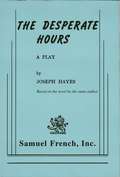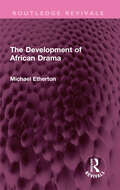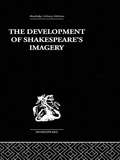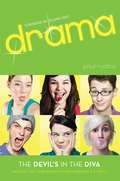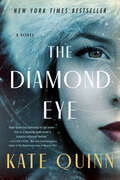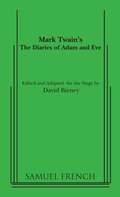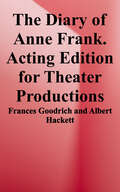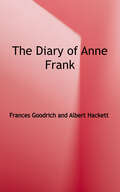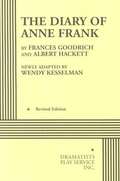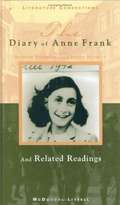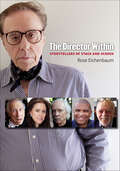- Table View
- List View
The Death of Character: Perspectives on Theater after Modernism (Drama and Performance Studies)
by Elinor Fuchs"Extremely well written, and exceedingly well informed, this is a work that opens a variety of important questions in sophisticated and theoretically nuanced ways. It is hard to imagine a better tour guide than Fuchs for a trip through the last thirty years of, as she puts it, what we used to call the 'avant-garde.'" —Essays in Theatre". . . an insightful set of theoretical 'takes' on how to think about theatre before and theatre after modernism." —Theatre Journal"In short, for those who never experienced a 'postmodern swoon,' Elinor Fuchs is an excellent informant." —Performing Arts Journal". . . a thoughtful, highly readable contribution to the evolving literature on theatre and postmodernism." —Modern Drama"A work of bold theoretical ambition and exceptional critical intelligence. . . . Fuchs combines mastery of contemporary cultural theory with a long and full participation in American theater culture: the result is a long-needed, long-awaited elaboration of a new theatrical paradigm." —Una Chaudhuri, New York University"What makes this book exceptional is Fuchs' acute rehearsal of the stranger unnerving events of the last generation that have—in the cross-reflections of theory—determined our thinking about theater. She seems to have seen and absorbed them all." —Herbert Blau, Center for Twentieth Century Studies, University of Wisconsin, Milwaukee"Surveying the extraordinary scene of the postmodern American theater, Fuchs boldly frames key issues of subjectivity and performance with the keenest of critical eyes for the compelling image and the telling gesture." —Joseph Roach, Tulane University" . . . Fuchs makes an exceptionally lucid and eloquent case for the value and contradictions in postmodern theater." —Alice Rayner, Stanford University"Arguably the most accessible yet learned road map to what remains for many impenetrable territoryan obligatory addition to all academic libraries serving upper-division undertgraduates and above." —Choice"A systematic, comprehensive and historically-minded assessment of what, precisely, 'post-modern theatre' is, anyway." —American TheatreIn this engrossing study, Elinor Fuchs explores the multiple worlds of theater after modernism. While The Death of Character engages contemporary cultural and aesthetic theory, Elinor Fuchs always speaks as an active theater critic. Nine of her Village Voice and American Theatre essays conclude the volume. They give an immediate, vivid account of contemporary theater and theatrical culture written from the front of rapid cultural change.
The Death of Hamlet: A Counterfactual Reading of Shakespeare (Routledge Studies in Shakespeare)
by Amir KhanThis book is an intervention in Hamlet scholarship. In Thus Spake Zarathustra (1885), Nietzsche famously posited the death of God, taken to mean the dissolution of all horizons within which human beings construct a plausible ontology that gives words significance. The idea of God, as a transcendental signified (to borrow from Derrida), underwrites meaning and values. Socrates placed knowing as the highest philosophical good over two millennia ago; however, once we find that God (i.e. any transcendental signified) is unknowable, the world vanishes. In a world bereft of concepts and meaning, Nietzsche’s philosophical project becomes one of “redeeming” pure willing as itself constitutive of world.Hamlet and the criticism surrounding it is caught within competing horizons we know are circuitous and unending. We tiresomely make theoretical rounds between competing sets of interpretations that boil down to either establishing meaning within the play (the text transcending its history and revealing universal truths) or situating the text within its proper historical timeframe in order to get it to speak. In short, we are trapped between contextualizing and decontextualizing approaches. Yet we know both approaches, as competing horizons we commit to at the outset, are dead. But to abandon both at the outset means that the text, Hamlet, is itself dead. So how to get it to speak?
The Death of Tragedy
by George SteinerAn engrossing and provocative look at the decline of tragedy in modern art"All men are aware of tragedy in life. But tragedy as a form of drama is not universal." So begins George Steiner's adept analysis of the demise of classic tragedy as a dramatic depiction of heroism and suffering. In The Death of Tragedy, Steiner examines the uniqueness and importance of the Greek classical tragedy--from antiquity to the age of Jean Racine and William Shakespeare--as providing stark insight into the grief and joy of human existence. Then, delving into the works of John Keats, Henrik Ibsen, Samuel Beckett, and many more, Steiner demonstrates how the tragic voice has greatly diminished in modern theater, and what we have lost in the process.
The Death of the Actor: Shakespeare on Page and Stage
by Martin BuzacottIn The Death of the Actor Martin Buzacott launches an all-out attack on contemporary theatrical practice and performance theory which identifies the actor, rather than the director, as the key creative force in the performance of Shakespeare. Because actors are absent from the site of Shakespearean meaning, he argues, the illusion of their centrality is sustained only by a rhetoric of heroism, violence and imperialism.
The December Man (L'homme de décembre)
by Colleen MurphyIn the aftermath of the 1989 Montreal Massacre, Benoît and Kathleen do everything they can to help their beloved son cope with his guilt and rage… but Jean's young life becomes unglued. Using humour and the humdrum of everyday life, Murphy intuitively moves backwards in time to the fateful day when Jean, the only ray of hope in this working-class family, escaped the massacre… or thought he did. This searing drama on courage, heroism, and despair explores the long private shadow that public violence casts. Winner of the 2007 Governor General's Literary Award for Drama and the 2008 CAA Carol Bolt Award.
The Decorator
by Donald ChurchillComedy . Characters: 1 male, 2 female. Interior Set. Marcia returns to her flat to find it has not been painted as she arranged. A part time painter who is filling in for an ill colleague is just beginning the work when the wife of the man with whom Marcia is having an affair arrives to tell all to Marcia's husband. Marcia hires the painter a part time actor to impersonate her husband at the confrontation. Hilarity is piled upon hilarity as the painter, who takes his acting very seriously, portrays the absent husband. The wronged wife decides that the best revenge is to sleep with Marcia's husband an ecstatic experience for them both. When Marcia learns that the painter/actor has slept with her rival, she demands the opportunity to show him what really good sex is. . "Irresistible." London Daily Telegraph. . "This play will leave you rolling in the aisles.... I all but fell from my seat laughing." London Star.
The Decroux Sourcebook
by Franc Chamberlain Thomas LeabhartThe Decroux Sourcebook is the first point of reference for any student of the ‘hidden master’ of twentieth century theatre. This book collates a wealth of key material on Etienne Decroux, including: an English translation of Patrice Pezin’s ‘Imaginary Interview’, in which Decroux discusses mime’s place in the theatre. previously unpublished articles by Decroux from France’s Bibiothèque Nationale. essays from Decroux’s fellow innovators Eugenio Barba and Edward Gordon Craig, explaining the synthesis of theory and practice in his work. Etienne Decroux’s pioneering work in physical theatre is here richly illustrated not only by a library of source material, but also with a gallery of images following his life, work and influences. The Decroux Sourcebook is an ideal companion to Thomas Leabhart’s Etienne Decroux in the Routledge Performance Practitioners series, offering key primary and secondary resources to those conducting research at all levels.
The Designated Mourner
by Wallace Shawn"The play nicely combines Pinterian menace with caustic political commentary." -Time"Acerbic, elusive, poetic and chilling, the writing is demanding in a rarefied manner. Its implications are both affecting and disturbing." -Los Angeles Times"In his exquisitely written dramatic lament for the decline of high culture. . . . [Shawn] offers a definition of the self that should rattle the defenses of intellectual snobs everywhere." -The New York TimesWriter and performer Wallace Shawn's landmark 1996 play features three characters--a respected poet, his daughter, and her English-professor husband--suspected of subversion in a world where culture has come under the control of the ruling oligarchy. Told through three interwoven monologues, the Orwellian political story is recounted alongside the visceral dissolution of a marriage. The play debuted at the Royal National Theatre in London, in a production directed by David Hare, who also directed the film version, starring Mike Nichols and Miranda Richardson. The play's subsequent New York premiere was staged in a long-abandoned men's club in lower Manhattan, directed by Shawn's longtime collaborator André Gregory.Wallace Shawn is the author of Our Late Night (OBIE Award for Best Play), Marie and Bruce, Aunt Dan and Lemon, The Fever, and the screenplay for My Dinner with André. His most recent play, Grasses of a Thousand Colors, premiered last year in London.
The Desperate Hours
by Joseph HayesMelodrama / 11m, 3f / Unit Set / A smash hit on Broadway with Paul Newman and winner of the Tony Award, this revised edition of The Desperate Hours has been simplified to employ a less complicated set. The Hilliards are a typical family living on the outskirts of Indianapolis; abruptly, their pleasant home becomes a jungle full of cunning and violence. Mr. Hilliard and 19 year old Cindy are allowed to go to work while Mrs. Hilliard and 10 year old Ralphie remain in the house as hostages. Meanwhile, the police search closes in inexorably, conducted by a deputy sheriff who has his own reasons for wanting to kill. The Hilliards are helpless. A murder occurs. The police move closer.
The Development of African Drama (Routledge Revivals)
by Michael EthertonOriginally published in 1982, this book explores concepts such as ‘traditional performance’ and African theatre’. It analyses the links between drama and ritual, and drama and music and diagnoses the confusions in our thought. The reader is reminded that drama is never merely the printed word, but that its existence as literature and in performance is necessarily different. The analysis shows that literature tends to replace performance; and drama, removed from the popular domain, becomes elitist. The book’s richness lies in the constantly stimulating analysis of ‘art’ theatre, as exemplified in protest plays, in African adaptations and transpositions of such classical subjects as the Bacchae and Everyman, in plays on African history, on colonialism and neo-colonialism. The final chapters argue that the form of African drama needs to evolve as the content does.
The Development of Shakespeare's Imagery (University Paperbacks Ser.)
by Wolfgang ClemenFirst published in 1951. The edition reprints the second, updated, edition, of 1977. When first published this book quickly established itself as the standard survey of Shakespeare's imagery considered as an integral part of the development of Shakespeare's dramatic art. By illustrating, through the use of examples the progressive stages of Shakespeare's use of imagery, and in relating it to the structure, style and subject matter of the plays, the book throws new light on the dramatist's creative genius. The second edition includes a new preface and an up-to-date bibliography.
The Devil and His Boy
by Anthony HorowitzThe English Ladder is a four-level course designed to help pupils take their first steps in English. Join the Fantastic family for fun, adventure and lively language learning through engaging stories, challenging songs, games, tongue twisters, and communication activities. This Level 3 Pupil's Book features topic-based units introducing new vocabulary, phonics activities for enjoyable pronunciation practice, a CLIL feature in every unit, focusing on core subjects such as science and maths, and clear grammar targets for each unit.
The Devil's Charter: A Tragedie, Conteining The Life And Death Of Pope Alexander The Sixt (classic Reprint) (Globe Quartos)
by Barnabe BarnesFirst Published in 1999. Routledge is an imprint of Taylor & Francis, an informa company.
The Devil's Disciple
by Bernard ShawPurchase of this book includes free trial access to www. million-books. com where you can read more than a million books for free. This is an OCR edition with typos. Excerpt from book: Act ra Early neat morning the sergeant, at the British headquarters in the Town Hall, unlocks the door of a littie empty panelled waiting room, and invites Judith to enter. She has had a bad night, probably a rather delirious one; for even in the reality of the raw morning, her fixed gaze comes back at moments when her attention is not strongly held. The sergeant considers that her feelings do her credit, and is sympathetic in an encouraging military way. Being a fine figure of a man, vain of his uniform and of his rank, he feels specially qualified, in a respectful way, to console her. Sergeant. You can have a quiet word with him here, mum. Judith. Shall I have long to wait ? Sergeant. No, mum, not a minute. We kep him in the Bridewell for the night; and he's just been brought over here for the court martial. Don't fret, mum: he slep like a child, and has made a rare good breakfast. Judith (incredulously). He is in good spirit a Sergeant. Tip top, mum. The chaplain looked in to see him last night; and he won seventeen shillings off him at spoil five. He spent it among us like the gentleman he is. Duty's duty, mum, of course; but you're among friends here. (The tramp of a couple of soldiers is heard approaching. ) There: I think he's coming. (Richard comes in, without a sign of care or captivity in his bearing. The sergeant nods to the two soldiers, and shews them the key of the room in his hand. They withdraw. ) Your good lady, sir. Richard (going to her). What My wife. My adored one. (He takes her hand and kisses it with a perverse, raffishgallantry. ') How long do you allow a brokenhearted husband for leave-taking, Sergeant? Sergeant. As long as we can, sir. We shall not disturb you till the court sits. Richard. But it has struck the hour. Sergea. . .
The Devil's in the Diva: The Four Dorothys; Everyone's a Critic (Drama!)
by Paul RuditisBryan Stark describes himself as the "Greek Chorus," constantly watching the action and drama unfold around him in the arena with the most high school divas possible--the theater! At his posh private school in Malibu, Orion Academy, the teens are entitled, the boys are cute, and the theatre productions extremely elaborate. Bryan sees it all as he directs his best friend Samantha, the most talented of the Orion divas, through the throng. This bind-up is filled with friends, theatre, and romance, but underneath it all DRAMA! is a heartfelt comedic series.
The Diamond Eye: A Novel
by Kate QuinnDon’t miss the thrilling new novel from Kate Quinn, The Briar Club, coming July 9th! New York Times BestsellerThe bestselling author of The Rose Code returns with an unforgettable World War II tale of a quiet bookworm who becomes history’s deadliest female sniper. Based on a true story.In 1937 in the snowbound city of Kyiv, wry and bookish history student Mila Pavlichenko organizes her life around her library job and her young son—but Hitler’s invasion of Ukraine and Russia sends her on a different path. Given a rifle and sent to join the fight, Mila must forge herself from studious girl to deadly sniper—a lethal hunter of Nazis known as Lady Death. When news of her three hundredth kill makes her a national heroine, Mila finds herself torn from the bloody battlefields of the eastern front and sent to America on a goodwill tour.Still reeling from war wounds and devastated by loss, Mila finds herself isolated and lonely in the glittering world of Washington, DC—until an unexpected friendship with First Lady Eleanor Roosevelt and an even more unexpected connection with a silent fellow sniper offer the possibility of happiness.But when an old enemy from Mila’s past joins forces with a deadly new foe lurking in the shadows, Lady Death finds herself battling her own demons and enemy bullets in the deadliest duel of her life.Based on a true story, The Diamond Eye is a haunting novel of heroism born of desperation, of a mother who became a soldier, of a woman who found her place in the world and changed the course of history forever.
The Diaries of Adam and Eve
by Mark Twain David BirneyComedy . Characters: 1 male, 1 female . Exterior Set. Originally broadcast on American Playhouse, this delightful adaptation is set in a Victorian garden and is structured as a series of diary entries by Adam and Eve. The play also works as a reader's theatre piece. At first, Adam is puzzled by the new arrival in the garden and he is suspicious of her disturbing appetite for fruit. Eve, believing herself to be some sort of experiment, is curious about another experiment in the garden, perhaps some sort of reptile or possibly architecture. Eve gives names to everything, much to Adam's annoyance. He tries to ignore her, so she seeks companionship among the animals particularly with a certain snake. Adam and Eve grow to love each other and, in the end, an elderly Adam is filled with a realization of that love as he stands at Eve's grave. "Sharp and resourceful...played with freshness and theatricality....charming." -Variety"...endearing...a reminder of Twain's storytelling genius and how much fun it can be...flavorful as apple cider, pungent, ironic." -The Los Angeles Times"Mark Twain isn't just for Hal Holbrook anymore. David Birney brings Mark Twain's words to life...in a romantic adventure for the ages." -Times Union, Albany, NY
The Diaries of Elizabeth Inchbald Vol 1
by Ben P RobertsonAn energetic woman, Inchbald achieved fame as an actress, novelist, playwright and critic. This work includes her eleven surviving diaries, which record Inchbald's social contacts and professional activities, itemize her day-to-day expenditure, and chart the development of affairs such as the Napoleonic Wars and the trial of Queen Caroline.
The Diary of Anne Frank
by Frances Goodrich Albert HackettA two-act play based on the diary of a Jewish girl who died in a Nazi concentration camp at the age of fifteen.
The Diary of Anne Frank
by Frances Goodrich Albert HackettThe Diary of Anne Frank by Frances Goodrich and Albert Hackett "This Drama Play is a wonderful addition to anyone who has a passion for Anne Frank related reading. A dramatization for the stage and ready for anyone, including schools, to use."
The Diary of Anne Frank (Acting Edition for Theater Productions)
by Albert Hackett Wendy Ann KesselmanA two-act play based on the diary of a Jewish girl who died in a Nazi concentration camp at the age of fifteen.
The Diary of Anne Frank and Related Readings (Literature Connections)
by Mcdougal LittellThis is the powerful play adapted from Anne Frank's famous diary. The play captures the hopes and fears of two Jewish families hiding in the attic for two years hoping to survive the Nazi witch hunt. As many know, the Franks were aided in hiding by Meis and Jan Giep, and Meis found Anne's diary shortly after the families were discovered and arrested by the Gestapo. In addition to the play and portions of Anne's famous diary, the book also includes several additional essays.
The Different Faces of Politics in the Visual and Performative Arts
by Mario Thomas Vassallo André P. DeBattistaThis book highlights the linkages between politics and governance and the arts. The essays in the volume show how visual and performative arts have challenged those in power — or conversely patronised by them — been used for propaganda, stir up national fervour and found themselves at the receiving end of political censure. They focus on the tension and symbiosis between the politician and the artist foregrounding how they have always tried to influence, challenge, and, in some cases, undermine one another. This volume will serve as an indispensable source for researchers and academics in political science, the humanities and performing arts.
The Director Within: Storytellers of Stage and Screen
by Rose EichenbaumIn Rose Eichenbaum's latest book on the confluence of art making and human expression, she sits down with thirty-five modern day storytellers—the directors of theater, film, and television. Eichenbaum's subjects speak with revealing clarity about the entertainment industry, the role and life of the director, and how theatrical and cinematic storytelling impacts our culture and our lives. The Director Within includes interviews with Peter Bogdanovich (The Last Picture Show), Julie Taymor (The Lion King), Mel Brooks (Blazing Saddles), Tim Van Patten (The Sopranos, Boardwalk Empire), Hal Prince (The Phantom of the Opera), Barry Levinson (Rain Man), and many others. The interviews are skillfully crafted, sensitively executed, and brimming with honesty and insight. The accompanying portraits demonstrate Eichenbaum's mastery of photography and convey the truth, depth, and intimacy of their subjects. The Director Within is an inspirational, informative, and entertaining resource for anyone interested in creativity, art making, and artistic collaboration. The book includes a listing of works from each of the directors.Publication of this book is funded by the Beatrice Fox Auerbach Foundation Fund at the Hartford Foundation for Public Giving.
